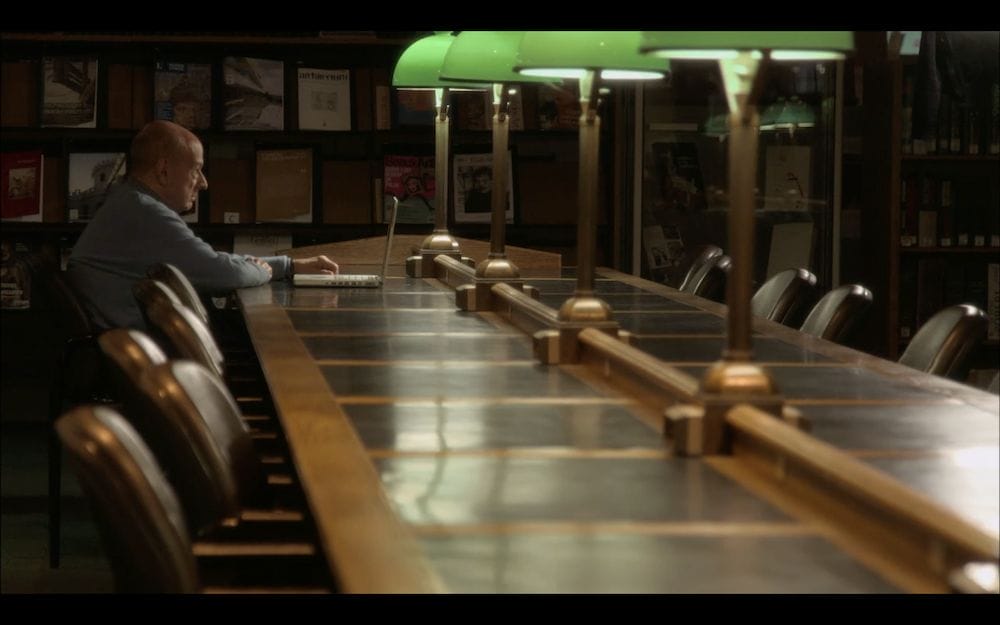We see a wide shot of a prison in black and white. The camera pans down to the courtyard, where groups of people, pacing aimlessly, are separated by cement walls. Guards in uniforms walk past rows of cells, inspecting each one. We cut to one of the cells where a person sits alone facing a barren wall.
A narrator explains that in 1971, in response to hunger strikes in prisons, French philosopher Michel Foucault founded the Prison Information Group (GIP) to show the exploitation within the prison system by using the accounts of prisoners.
We cut to a prison with smoke billowing from its windows and hear sounds of a siren increase. Prisoners gather on top of the prison roof to throw bricks down at the police below. The police fire smoke bombs, causing the prisoners to flee and scatter. We cut to an image of Foucault standing before the press, in the middle of a passionate diatribe, protesting outside of the Justice Ministry. He is seen accompanied by Jean-Paul Sartre, Gillies Deleuze, and other members of the GIP.
“My purpose is to collect information, disseminate it and possibly provoke opinions,” Foucault says. “I observe that which is intolerable.”
Revealing the History of Our Contemporary Society
In Foucault Against Himself, director Francois Caillat creates an overview of the works of Michel Foucault, one of the most influential philosophers of the later 20th century. Caillat shows the ways in which Foucault showed the history of insanity, sexuality, punishment, and science, just to name a few. The director illustrates this by showing images and artifacts relating to these subjects. We see illustrations and engravings of prisoners being tortured, people being publicly punished, and the tools used to punish, such as fetters, chains, and stocks.
The filmmaker focuses on art that depicts lunatics and madmen. Statues from ancient Greece show lunatics, which Foucault described, as “figures of reason, with a hold on truth.” Later, we see 17th century engravings revealing the insane as their villages drag them by the arm and cast them out into the forest. Then, in the 19th century, Foucault described how insanity became medicalized. For this, Caillat chooses to film labeled diagrams of the brain, shelves filled with medicine bottles, and old photos of mental asylums. We see images of and hooking them up to electroshock therapy machines.
OVID.tv’s FOUCAULT AGAINST HIMSELF Gives an Overview of the Ideas of an Influential and Infamous Thinker
In this writer’s opinion, Foucault Against Himself provides a detailed and condensed overview of Foucault’s work. Caillat provides an accessible way for one to understand the philosopher’s subversive, post-structuralist, postmodern ideas, and how these ideas relate to the world we live in. However, if one is looking for a complete biography of Foucault’s life, they will be disappointed with the lack of attention this documentary gives it. Yet if one wishes to learn why Foucault has become such an influential figure, this is a must watch.
RECOMMENDED
Nominate this for The Picture This Post BEST OF 2021???
Click Readers' ChoiceWant to see who won the Picture This Post READERS’ CHOICE competition last year?
WATCH THIS SHORT VIDEO—
Director and Writer: Francois Caillat
Cinematographer: Isabelle Razavet
Editor: Martine Bouquin
To watch the film, visit the OVID.tv page for FOUCAULT AGAINST HIMSELF.
Images courtesy of OVID.tv

About the Author: Jeffrey Bobb
Jeffrey has had a love for writing ever since reading the works of J.R.R. Tolkein and H.P. Lovecraft. Throughout his life he life he has strived to read as much as possible, including the classics, science-fiction, philosophy, horror, psychology, fantasy, and politics. A self-proclaimed political junkie, he always has an opinion for any current event or issue. In his spare time, he enjoys reading, listening to vinyls, getting lost in bookstores or libraries, and watching movies.







